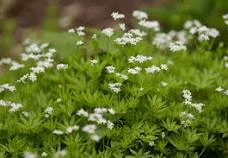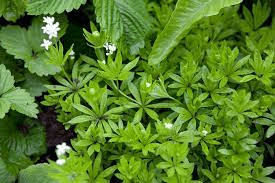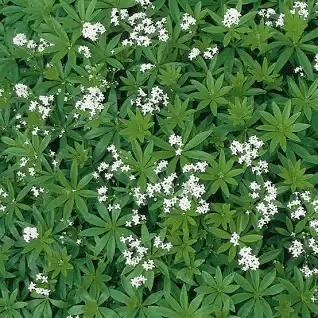Sweet Woodruff, scientifically known as Galium odoratum, is a perennial plant that belongs to the Rubiaceae family. Here are some of its key characteristics:
The plant grows to 30–50 cm long, often lying flat on the ground or supported by other plants.
The small flowers (4–7 mm diameter) are produced in cymes, each white with four petals joined together at the base.
The leaves are simple, lanceolate, glabrous, 2–5 cm long, and borne in whorls of 6–9.
The Botanical Description of Sweet Woodruff
1. Plant Structure: Sweet Woodruff boasts a low-growing habit, reaching a height of 15 to 30 cm. Its stems are quadrangular, and the plant tends to spread, forming a lush ground cover.
2. Leaves: The lance-shaped leaves are arranged in whorls, typically consisting of six to eight leaves per whorl. These leaves are glossy green and exude a sweet aroma when crushed.
3. Flowers: The small, star-shaped flowers of Sweet Woodruff are white and bloom in clusters. The blossoms contribute to the plant’s visual appeal and fragrance.
4. Height: Sweet Woodruff typically reaches a height of 15 to 30 cm, creating a carpet-like effect in shaded areas.
5. Habitat: This herbaceous perennial thrives in shady woodlands, preferring moist and well-drained soils. It is a resilient plant that adapts well to various growing conditions.
6. Blooming Period: Sweet Woodruff blooms in late spring to early summer, adding a touch of elegance to shaded gardens.
7. Root System: The plant develops a rhizomatous root system, aiding in its ability to spread and form dense ground covers.
8. Botanical Family: Sweet Woodruff belongs to the Rubiaceae family, which includes other well-known plants like coffee and cleavers.
9. Aromatic Qualities: The leaves of Sweet Woodruff possess a distinct hay-like fragrance, intensifying when dried. This aromatic quality makes it a sought-after herb in various applications.
10. Traditional Use: Historically, Sweet Woodruff has been used as a strewing herb to impart fragrance to living spaces and as a flavoring agent in beverages like May Wine.
The Geographic Distribution of Sweet Woodruff
1. Europe: Sweet Woodruff is native to Europe and can be found in woodlands across countries like Germany, France, and the United Kingdom.
2. North America: Introduced to North America, Sweet Woodruff has naturalized in certain regions, particularly in shaded areas with suitable growing conditions.
3. Asia: In Asia, Sweet Woodruff has been cultivated and utilized in traditional medicine and culinary practices.
4. Australia: While not native, Sweet Woodruff has been cultivated in Australia, adding a touch of European charm to gardens.
5. Africa: Limited distribution in parts of Africa, including gardens and cultivated spaces.
6. New Zealand: Sweet Woodruff has found a home in New Zealand, where it is appreciated for its aromatic qualities and ground cover attributes.
7. South America: Limited presence in certain regions of South America, primarily in gardens and cultivated spaces.
8. Scandinavia: Sweet Woodruff is well-distributed in Scandinavia, where it adds a touch of elegance to shaded landscapes.
9. North Asia: The plant can be found in certain regions of North Asia, contributing to its global distribution.
The Chemical Composition of Sweet Woodruff
1. Coumarins: Sweet Woodruff is rich in coumarins, compounds that contribute to its sweet fragrance. Coumarins also have potential medicinal properties.
2. Tannins: Tannins, known for their astringent qualities, are present in Sweet Woodruff, influencing its traditional uses.
3. Flavonoids: The plant contains flavonoids, which are antioxidants that contribute to its overall health profile.
4. Essential Oils: Sweet Woodruff produces essential oils, adding to its aromatic qualities and potential therapeutic uses.
5. Galioside: Galioside, a compound found in Sweet Woodruff, may have anti-inflammatory properties.
6. Polysaccharides: The presence of polysaccharides contributes to the plant’s mucilaginous texture.
7. Alkaloids: While present in small amounts, alkaloids contribute to the plant’s chemical composition.
8. Vitamin C: Sweet Woodruff contains vitamin C, adding a nutritional element to its profile.
9. Minerals: The plant provides minerals, including calcium and potassium, enhancing its overall nutrient content.
10. Organic Acids: Sweet Woodruff contains organic acids, contributing to its flavor and potential medicinal effects.
11. Phenolic Compounds: Phenolic compounds, known for their antioxidant properties, are part of Sweet Woodruff’s chemical makeup.
12. Lignans: Lignans are present in Sweet Woodruff, and their potential health benefits are an area of ongoing research.
Read Also: Devon Rexes Cat (Felis catus) Description and Complete Care Guide
The Medicinal Health Benefits of Sweet Woodruff (Galium odoratum)

1. Calming Effects: Sweet Woodruff has been traditionally used for its calming properties, making it a popular choice for herbal teas aimed at promoting relaxation.
2. Anti-Inflammatory Action: Compounds like galioside and flavonoids contribute to Sweet Woodruff’s potential anti-inflammatory effects, addressing conditions associated with inflammation.
3. Digestive Aid: The plant’s mild astringency and organic acids may offer digestive support, helping alleviate mild gastrointestinal discomfort.
4. Respiratory Support: Sweet Woodruff has been employed to address respiratory issues, with its aromatic qualities potentially offering relief from congestion.
5. Antioxidant Protection: The presence of flavonoids, phenolic compounds, and vitamin C provides Sweet Woodruff with antioxidant capabilities, protecting cells from oxidative stress.
6. Mild Diuretic: Sweet Woodruff’s diuretic properties may contribute to mild fluid balance, supporting urinary tract health.
7. Skin Health: The application of Sweet Woodruff-infused preparations may offer benefits to the skin, promoting a healthy complexion.
8. Traditional Culinary Uses: In addition to its medicinal applications, Sweet Woodruff is used as a flavoring agent in beverages and desserts, adding a unique and pleasant taste.
9. Menstrual Support: Traditionally, Sweet Woodruff has been employed to support a healthy menstrual cycle, with potential benefits for menstrual discomfort.
10. Stress Reduction: The calming effects of Sweet Woodruff may contribute to stress reduction and overall well-being.
11. Sleep Aid: Some individuals use Sweet Woodruff for its potential to promote relaxation and support a restful night’s sleep.
12. Anti-Bacterial Properties: Preliminary research suggests that Sweet Woodruff may possess antibacterial properties, potentially contributing to immune defense.
13. Cognitive Support: The calming and anti-inflammatory effects of Sweet Woodruff may have positive implications for cognitive function.
14. Joint Health: Traditional uses indicate that Sweet Woodruff may offer support for joint health, potentially alleviating mild discomfort.
15. Cardiovascular Health: Antioxidant compounds in Sweet Woodruff may contribute to cardiovascular health by protecting against oxidative damage.
16. Allergy Relief: Some individuals use Sweet Woodruff for its potential to alleviate mild allergy symptoms, although more research is needed.
17. Anti-Rheumatic Properties: Traditional applications suggest that Sweet Woodruff may have anti-rheumatic effects, supporting joint health.
18. Headache Relief: Sweet Woodruff’s calming effects may extend to providing relief from mild headaches, according to traditional uses.
19. Anti-Spasmodic Actions: Compounds in Sweet Woodruff may have mild anti-spasmodic effects, contributing to muscle relaxation.
The Methods of Usage to Achieve the Provided Health Benefits of Sweet Woodruff (Galium odoratum)
1. Herbal Tea: Prepare a soothing herbal tea by infusing dried Sweet Woodruff leaves in hot water. This method is ideal for promoting relaxation and addressing stress.
2. Poultices: Create poultices with fresh or dried Sweet Woodruff and apply them topically to support skin health or provide relief to joints.
3. Culinary Use: Infuse beverages or desserts with Sweet Woodruff for a unique flavoring experience, adding both taste and potential health benefits.
4. Aromatic Sachets: Utilize dried Sweet Woodruff in aromatic sachets to impart a pleasant fragrance to living spaces, promoting a sense of calm.
5. Tinctures: Prepare tinctures with Sweet Woodruff for a concentrated form that can be added to beverages or taken directly for potential medicinal effects.
6. Bath Soaks: Add dried Sweet Woodruff to your bath for a relaxing experience that may contribute to skin health and overall well-being.
7. Steam Inhalation: Inhale the steam infused with Sweet Woodruff for potential respiratory support and relaxation.
8. Herbal Infused Oil: Create herbal-infused oil with Sweet Woodruff to apply topically for potential skin benefits or as a massage oil.
9. Culinary Garnish: Fresh leaves of Sweet Woodruff can be used as a garnish in salads or desserts, adding both visual appeal and flavor.
10. Herbal Syrups: Prepare herbal syrups using Sweet Woodruff for a sweet and aromatic addition to beverages, potentially offering mild medicinal benefits.
The Side Effects of Using Sweet Woodruff Medicinal Plant
1. Allergic Reactions: Individuals with known allergies to the Rubiaceae family, which includes Sweet Woodruff, should exercise caution to avoid potential allergic reactions.
2. Photosensitivity: Some individuals may experience increased sensitivity to sunlight after using Sweet Woodruff, necessitating sun protection.
3. Pregnancy and Breastfeeding: Pregnant or breastfeeding individuals should exercise caution, as the effects of Sweet Woodruff during these periods are not well-established.
4. Gastrointestinal Discomfort: In rare cases, the consumption of Sweet Woodruff may cause mild gastrointestinal discomfort.
5. Potential Drug Interactions: Sweet Woodruff may interact with certain medications, so it’s crucial to consult a healthcare professional before using it medicinally.
6. Not Recommended for Children: The safety of Sweet Woodruff in children is not well-established, so it’s generally not recommended for use in this population.
7. Liver Disorders: Individuals with liver disorders should use Sweet Woodruff cautiously, as specific effects on liver function are not well-documented.
8. Blood Clotting: Due to its potential effects on blood clotting, Sweet Woodruff should be used cautiously by individuals taking blood-thinning medications.
9. Excessive Use: Excessive use of Sweet Woodruff may lead to adverse effects, and moderation is key when incorporating it into health routines.
10. Central Nervous System Depression: The calming effects of Sweet Woodruff may contribute to central nervous system depression, so it’s advisable to avoid excessive consumption, especially when operating machinery or driving.
11. Kidney Disorders: Individuals with kidney disorders should use Sweet Woodruff cautiously, as its diuretic effects may impact kidney function.
12. Respiratory Sensitivity: Individuals with respiratory sensitivities should be cautious when inhaling Sweet Woodruff steam, as it may trigger respiratory reactions.
Read Also: 10 Medicinal Health Benefits Of Meadowsweet (Filipendula ulmaria)
The Scientific Research and Studies of Sweet Woodruff

1. Antioxidant Properties: Scientific research has explored the antioxidant properties of Sweet Woodruff, shedding light on its potential role in combating oxidative stress within the body. Antioxidants play a crucial role in protecting cells from damage caused by free radicals.
2. Anti-Inflammatory Effects: Studies have delved into Sweet Woodruff’s anti-inflammatory potential, indicating its ability to modulate inflammatory pathways. This suggests potential applications for managing conditions associated with inflammation.
3. Anti-Microbial Activity: Preliminary research has investigated the anti-microbial activity of Sweet Woodruff. Compounds present in the plant may exhibit inhibitory effects against certain microorganisms, contributing to its traditional use in herbal medicine.
4. Wound Healing: Scientific investigations have explored Sweet Woodruff’s role in wound healing. The plant’s potential to promote tissue regeneration and reduce inflammation makes it a subject of interest in the realm of natural wound care.
5. Neuroprotective Effects: Some studies have suggested neuroprotective effects associated with Sweet Woodruff. These effects may be attributed to specific compounds that could potentially support cognitive health.
6. Anti-Rheumatic Potential: Research has indicated that Sweet Woodruff may have anti-rheumatic properties. This aligns with its traditional use in addressing joint health and mild discomfort.
7. Effects on the Respiratory System: Studies have explored the effects of Sweet Woodruff on the respiratory system, indicating potential benefits for respiratory health. Its aromatic qualities may contribute to relief from respiratory congestion.
8. Impact on Cardiovascular Health: Scientific investigations have looked into the potential cardiovascular benefits of Sweet Woodruff. Antioxidant compounds found in the plant may contribute to overall heart health.
9. Immunomodulatory Properties: Research suggests that Sweet Woodruff may possess immunomodulatory effects, potentially enhancing the body’s immune responses. This property could contribute to overall wellness and resilience.
10. Validation of Traditional Uses: Scientific studies have sought to validate the traditional uses of Sweet Woodruff. The aim is to bridge traditional knowledge with scientific evidence, providing a comprehensive understanding of the plant’s medicinal properties.
The Safety Precautions and Recommendations In Using Sweet Woodruff Medicinal Plant
1. Allergic Sensitivity: Individuals with known allergies to the Rubiaceae family, which includes Sweet Woodruff, should exercise caution. Conduct a patch test before topical application or consumption.
2. Photosensitivity: Due to the potential for increased sensitivity to sunlight, users of Sweet Woodruff should employ sun protection measures, especially after topical applications.
3. Consultation with Healthcare Professionals: Before incorporating Sweet Woodruff into a medicinal regimen, individuals on medications or with underlying medical conditions should consult healthcare professionals. This is particularly crucial for pregnant and breastfeeding individuals.
4. Pregnancy and Breastfeeding: Pregnant or breastfeeding individuals should avoid Sweet Woodruff unless approved by a healthcare provider. Limited information is available on its safety during these periods.
5. Gastrointestinal Upset: In rare cases, the consumption of Sweet Woodruff may cause mild gastrointestinal discomfort. Discontinue use if adverse effects occur.
6. Blood Clotting Disorders: Due to its potential effects on blood clotting, individuals with blood clotting disorders or those taking anticoagulant medications should use Sweet Woodruff cautiously.
7. Excessive Use: Excessive use of Sweet Woodruff may lead to adverse effects. Adhere to recommended dosages and moderation in consumption.
8. Central Nervous System Depression: The calming effects of Sweet Woodruff may contribute to central nervous system depression. Avoid excessive consumption, especially when operating machinery or driving.
9. Not Recommended for Children: The safety of Sweet Woodruff in children is not well-established. It’s generally not recommended for use in this population.
10. Liver Disorders: Individuals with liver disorders should use Sweet Woodruff cautiously, as specific effects on liver function are not well-documented.
11. Blood Pressure: Individuals with low blood pressure should be cautious, as Sweet Woodruff’s mild hypotensive effects could potentially lower blood pressure further.
12. Respiratory Sensitivity: Individuals with respiratory sensitivities should be cautious when inhaling Sweet Woodruff steam, as it may trigger respiratory reactions.
FAQs About Sweet Woodruff Medicinal Plant
1. Can Sweet Woodruff be consumed as a food source? Yes, Sweet Woodruff is used in culinary applications, such as flavoring beverages and desserts.
2. Is Sweet Woodruff safe for pregnant women? Pregnant women should consult their healthcare provider before using Sweet Woodruff due to limited safety data.
3. How long does it take to experience the health benefits of Sweet Woodruff? The timeframe for experiencing benefits varies, and consistency in usage is key.
4. Can Sweet Woodruff be used for children’s skin conditions? The safety of Sweet Woodruff in children is not well-established. Consult a healthcare professional before use.
5. Are there any known drug interactions with Sweet Woodruff? Sweet Woodruff may interact with certain medications. It’s crucial to consult a healthcare professional.
6. Can Sweet Woodruff be used alongside other herbal supplements? Consulting with a healthcare provider is advisable before combining Sweet Woodruff with other herbal supplements.
7. How does Sweet Woodruff support respiratory health? The aromatic qualities of Sweet Woodruff may contribute to respiratory relief when inhaled or consumed.
8. Can Sweet Woodruff be used for skin conditions? Sweet Woodruff may offer benefits to the skin when applied topically, supporting a healthy complexion.
9. Is Sweet Woodruff recommended for individuals with arthritis? Sweet Woodruff’s potential anti-inflammatory effects may offer relief to individuals with arthritis, but consultation with a healthcare professional is advised.
10. Can Sweet Woodruff be used topically for wound healing? Yes, Sweet Woodruff can be applied topically to promote wound healing, potentially reducing inflammation and supporting tissue regeneration.
11. How should Sweet Woodruff be stored for optimal freshness? Store dried Sweet Woodruff in an airtight container in a cool, dark place to maintain its potency and freshness.
12. Can Sweet Woodruff be used to alleviate menstrual discomfort? Sweet Woodruff has been traditionally used to support a healthy menstrual cycle and alleviate menstrual discomfort.
13. What is the recommended dosage of Sweet Woodruff for medicinal use? Dosage may vary depending on the form of Sweet Woodruff used and the specific health goal. Consulting with a herbalist or healthcare professional is advisable.
14. How can Sweet Woodruff be incorporated into a daily health routine? Sweet Woodruff can be consumed as a tea, added to culinary dishes, or used in various forms based on individual preferences and health goals.
15. Are there any known interactions with Sweet Woodruff and hormonal medications? Individuals taking hormonal medications should consult with their healthcare provider before using Sweet Woodruff.
16. Is Sweet Woodruff safe for long-term use? While Sweet Woodruff is generally considered safe, it’s advisable to take breaks from long-term use and consult with a healthcare professional for personalized guidance.
17. Can Sweet Woodruff be used as a preventive measure for certain health conditions? Some individuals incorporate Sweet Woodruff into their wellness routine as a preventive measure, but its efficacy may vary. Professional guidance is recommended.
18. Can Sweet Woodruff be used alongside conventional medical treatments? Individuals undergoing conventional medical treatments should consult with their healthcare provider before incorporating Sweet Woodruff into their regimen.
Read Also: How To Raise Chickens – The Simple Secrets To A Great Backyard Flock

